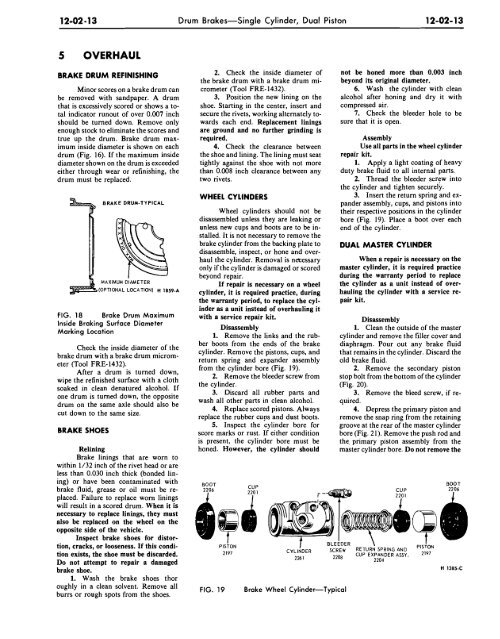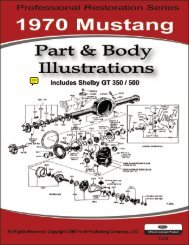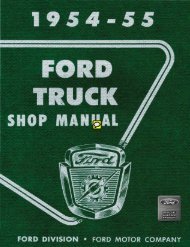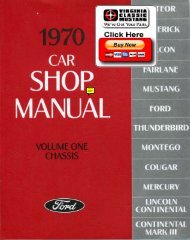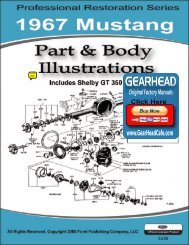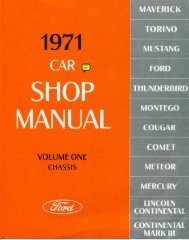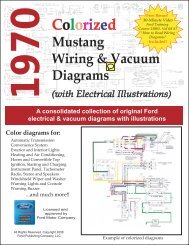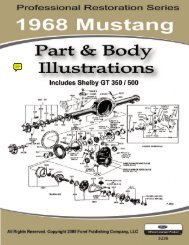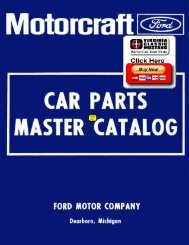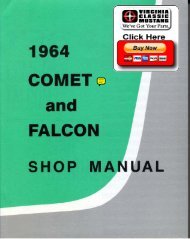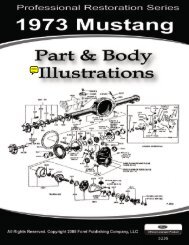DEMO - 1972 Ford Car Shop Manual (Vol I-V) - ForelPublishing.com
DEMO - 1972 Ford Car Shop Manual (Vol I-V) - ForelPublishing.com
DEMO - 1972 Ford Car Shop Manual (Vol I-V) - ForelPublishing.com
You also want an ePaper? Increase the reach of your titles
YUMPU automatically turns print PDFs into web optimized ePapers that Google loves.
.urn Brakes-Single Cylinder, Dual Piston 12-02- 13<br />
5 OVERHAUL<br />
BRAKE DRUM REFINISHING<br />
Minor scores on a brake drum can<br />
be removed with sandpaper. A drum<br />
that is excessively scored or shows a total<br />
indicator runout of over 0.007 inch<br />
should be turned down. Remove only<br />
enough stock to eliminate the scores and<br />
true up the drum. Brake drum maximum<br />
inside diameter is shown on each<br />
drum (Fig. 16). If the maximum inside<br />
diameter shown on the drum is exceeded<br />
either through wear or refinishing, the<br />
drum must be replaced.<br />
BRAKE DRUM-TYPICAL<br />
MAXIMUM DIAMETER<br />
(OPTIONAL LOCATION) H 1859-A<br />
FIG. 18 Brake Drum Maximum<br />
Inside Braking Surface Diameter<br />
Marking Location<br />
Check the inside diameter of the<br />
brake drum with a brake drum micrometer<br />
(Tool FRE-1432).<br />
After a drum is turned down,<br />
wipe the refinished surface with a cloth<br />
soaked in clean denatured alcohol. If<br />
one drum is turned down, the opposite<br />
drum on the same axle should also be<br />
cut down to the same size.<br />
BRAKE SHOES<br />
Relining<br />
Brake linings that are worn to<br />
within 1/32 inch of the rivet head or are<br />
less than 0.030 inch thick (bonded lining)<br />
or have been contaminated with<br />
brake fluid, grease or oil must be replaced.<br />
Failure to replace worn linings<br />
will result in a scored drum. When it is<br />
necessary to replace linings, they must<br />
also be replaced on the wheel on the<br />
opposite side of the vehicle.<br />
Inspect brake shoes for distortion,<br />
cracks, or looseness. If this condition<br />
exists, the shoe must be discarded.<br />
Do not attempt to repair a damaged<br />
brake shoe.<br />
1. Wash the brake shoes thor<br />
oughly in a clean solvent. Remove all<br />
burrs or rough spots from the shoes.<br />
2. Check the inside diameter of<br />
the brake drum with a brake drum micrometer<br />
(Tool FRE-1432).<br />
3. Position the new lining on the<br />
shoe. Starting in the center, insert and<br />
secure the rivets, working alternately towards<br />
each end. Replacement linings<br />
are ground and no further grinding is<br />
required.<br />
4. Check the clearance between<br />
the shoe and lining. The lining must seat<br />
tightly against the shoe with not more<br />
than 0.008 inch clearance between any<br />
two rivets.<br />
WHEEL CYLINDERS<br />
Wheel cylinders should not be<br />
disassembled unless they are leaking or<br />
unless new cups and boots are to be installed.<br />
It is not necessary to remove the<br />
brake cylinder from the backing plate to<br />
disassemble, inspect, or hone and overhaul<br />
the cylinder. Removal is necessary<br />
only if the cylinder is damaged or scored<br />
beyond repair.<br />
If repair is necessary on a wheel<br />
cylinder, it is required practice, during<br />
the warranty period, to replace the cylinder<br />
as a unit instead of overhauling it<br />
with a service repair kit.<br />
Disassembly<br />
1. Remove the links and the rubber<br />
boots from the ends of the brake<br />
cylinder. Remove the pistons, cups, and<br />
return spring and expander assembly<br />
from the cylinder bore (Fig. 19).<br />
2. Remove the bleeder screw from<br />
the cylinder.<br />
3. Discard all rubber parts and<br />
wash all other parts in clean alcohol.<br />
4. Replace scored pistons. Always<br />
replace the rubber cups and dust boots.<br />
5. Inspect the cylinder bore for<br />
score marks or rust. If either condition<br />
is present, the cylinder bore must be<br />
honed. However, the cylinder should<br />
BOOT<br />
2206<br />
FIG. 19<br />
t<br />
PISTON<br />
2197<br />
CUP<br />
Brake Wheel Cylinder-Typical<br />
not be honed more than 0.003 inch<br />
beyond its original diameter.<br />
6. Wash the cylinder with clean<br />
alcohol after honing and dry it with<br />
<strong>com</strong>pressed air.<br />
7. Check the bleeder hole to be<br />
sure that it is open.<br />
Assembly<br />
Use all parts in the wheel cylinder<br />
repair kit.<br />
1. Apply a light coating of heavy<br />
duty brake fluid to all internal parts.<br />
2. Thread the bleeder screw into<br />
the cylinder and tighten securely.<br />
3. Insert the return spring and expander<br />
assembly, cups, and pistons into<br />
their respective positions in the cylinder<br />
bore (Fig. 19). Place a boot over each<br />
end of the cylinder.<br />
DUAL MASTER CYLINDER<br />
When a repair is necessary on the<br />
master cylinder, it is required practice<br />
during the warranty period to replace<br />
the cylinder as a unit instead of overhauling<br />
the cylinder with a service repair<br />
kit.<br />
Disassembly<br />
1. Clean the outside of the master<br />
cylinder and remove the filler cover and<br />
diaphragm. Pour out any brake fluid<br />
that remains in the cylinder. Discard the<br />
old brake fluid.<br />
2. Remove the secondary piston<br />
stop bolt from the bottom of the cylinder<br />
(Fig. 20).<br />
3. Remove the bleed screw, if required.<br />
4. Depress the primary piston and<br />
remove the snap ring from the retaining<br />
groove at the rear of the master cylinder<br />
bore (Fig. 21). Remove the push rod and<br />
the, primary piston assembly from the<br />
master cylinder bore. Do not remove the<br />
BOOT


